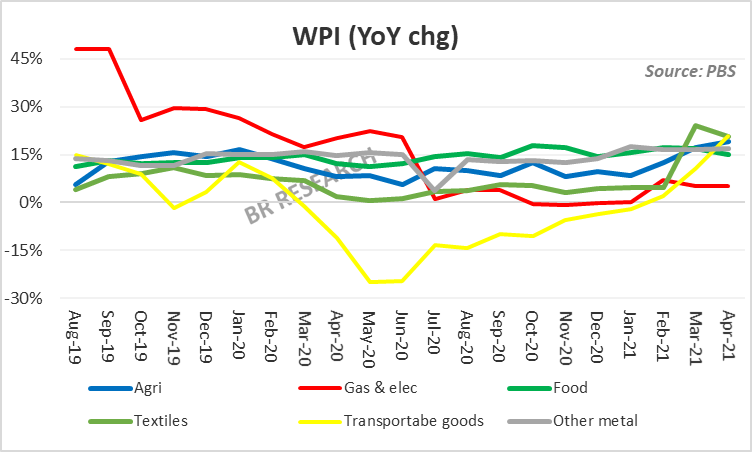The CPI inflation at 11 percent for April 2021 surprised quite a few. Some are quick to brush it aside as a one-off and maintain the near to medium-term projection of 7-8 percent. From how things have shaped up on the wholesale front, it looks as if the CPI inflation may not be cooling off in a hurry. The Wholesale Price Index (WPI) tracked by the Pakistan Bureau of Statistics (PBS), shows a 23-month high, having recorded its lowest ever reading in June 2020.
Not quite the perfect correlation, but WPI does have a history of being a leading indicator to the CPI movements. The 2019 all-time highs and 2020 all-time lows for the WPI were flagged in this space and on both occasions, WPI proved to be a leading CPI indicator. The 2020 dip in the WPI was always going to be short-lived as it was largely driven by a massive Covid-led decline in transportable good prices – mainly petroleum products.

The WPI composition could give a sneak peak into what the CPI would look like in the near future. Agricultural products have the single largest weight in WPI, constituting one-fourth of the WPI basket. The WPI reading for agriculture products was recorded at the highest ever for April 2021. The bulk of agriculture basket is non-perishable food items, which generally do not tend to see price reversals. This implies the high agri WPI is likely to lead to higher food WPI, which has one-fifth of the overall WPI weight.

Textile and apparels have 10 percent weight in the WPI basket – that has grown by unprecedented 24 and 20 percent year-on-year in the last two months. It is particularly concerning because textile and apparel category has been the least volatile of all – having increased at an average of no more than 5 percent. Cotton yarn makes up for more than half of the category and is responsible for bulk of the increase. It can be said with some degree of certainty that such high increase in wholesale textile and apparel prices, will surely hit the retail markets, sooner than later.

The government has of late been trying hard not to pass on the impact of oil prices to the petroleum users by lowering tax incidence. That said, the WPI will keep showing double-digit increase on year-on-year basis, as oil prices had crashed last year during the Covid first wave. There maybe some respite in terms of energy pricing as plans of further increasing the tariffs seem to have been put on hold.
The relation with CPI is obviously not as straightforward, but enough of what has been happening around WPI suggests there will definitely be an impact on retail prices very soon. The worries on the CPI front appear far from over.

























Comments
Comments are closed.